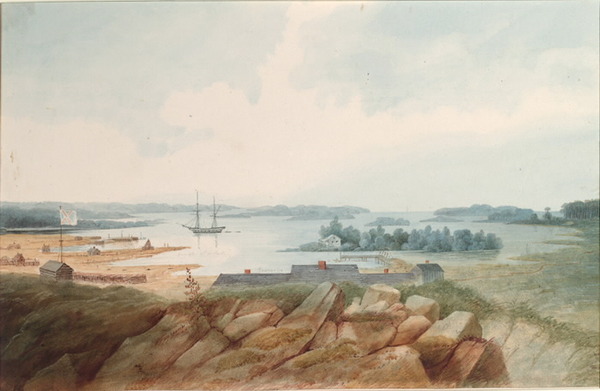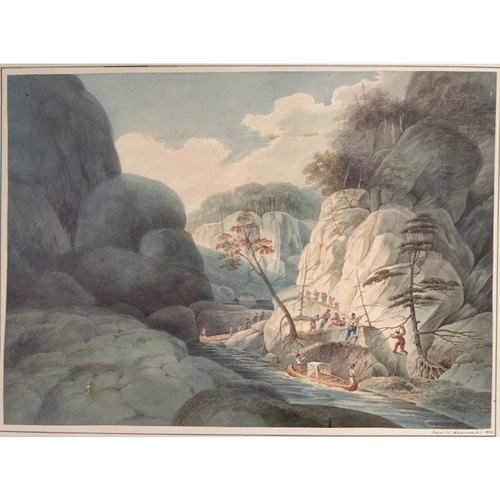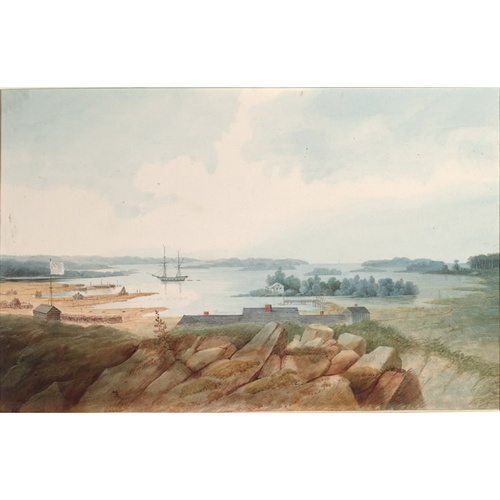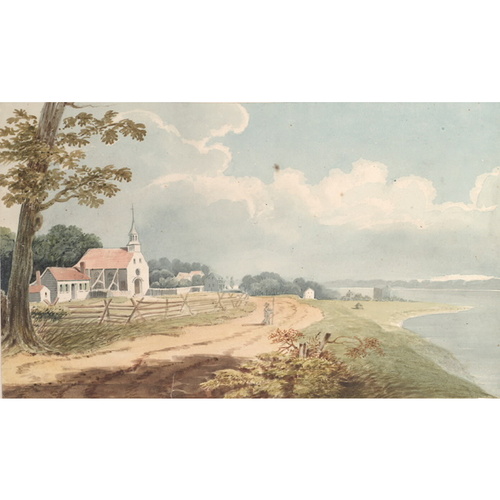WOOLFORD, JOHN ELLIOTT, artist, topographical draughtsman, and architect; b. 1778 in London, England; d. 1866 at Fredericton, N.B.
John Elliott Woolford evidently spent some years studying drawing, probably as an apprentice in the Drawing Room of the Board of Ordnance in the Tower of London. He may also have studied under Paul Sandby, professor of drawing at the Royal Military Academy, Woolwich, who had perfected a method of etching called aquatint, in which Woolford became skilful. His experience at the Board of Ordnance may have gained him a commission in the Royal Artillery or the Royal Engineers since there are consistent references to him as Major Woolford. He had entered the army as a young man and served in the Napoleonic wars, participating in the victorious campaign against Napoleon Bonaparte’s army in Egypt, where his merits as a landscape artist and sketcher attracted the attention of the Earl of Dalhousie [Ramsay*]. Under Lord Dalhousie’s patronage he settled in Scotland as an artist about 1807 after retiring from the army on half pay. While in Scotland he married Margaret Erskine, who was related to Anne Dundas, wife of Sir Howard Douglas, later lieutenant governor of New Brunswick from 1823 to 1831.
When Lord Dalhousie arrived in Nova Scotia in October 1816 as the new lieutenant governor and commander-in-chief, Woolford was in his entourage as official draughtsman. In the Acadian Recorder of 26 June 1819 Woolford advertised engravings of two views of Dalhousie Castle, and described himself as “landscape and portrait painter and Draughtsman to His Excellency,” under whose patronage the plates were offered. He also announced the first collection in “A Series of Picturesque Views of Nova Scotia,” drawn and engraved by himself and printed in aquatint; it consisted of two views of Government House, a “perspective” view, and an elevation of the newly opened Province House. Accompanying Lord Dalhousie on his extensive travels through the colony, Woolford recorded his impressions of the towns and villages, the topography of the land, its forests, waterways, and historic sites in precise but vigorous line and-wash drawings in sepia, suitable for future translation to aquatint prints.
Dated drawings indicate that when Lord Dalhousie left for Quebec in June 1820 to assume his new appointment as governor general of Canada, Woolford remained in Halifax. He was there until 1821, probably to supervise the construction of Dalhousie College. Lord Dalhousie had endowed the college and Woolford is said to have designed the new building, of which he painted a water-colour in 1822. In 1821, when Lord Dalhousie made a tour of Lower and Upper Canada as far as Lake Superior, Woolford was summoned to attend him as official draughtsman, and sketched the principal places and significant scenery on their route.
In 1823, through the earl’s influence, Woolford was appointed assistant barrack-master at Saint John, N.B., and then barrack-master general at headquarters in Fredericton, an appointment he held for 36 years. His talents as an architect were employed by the army, and the design for the officers’ quarters, completed in 1839, is attributed to him, although the only signature on the plan and elevation is Lieutenant Henry Wentworth’s endorsement as garrison engineer officer.
Woolford’s most notable achievements as an architect in Fredericton included his design for the new government house after the wooden mansion built by Governor Thomas Carleton*’s had been destroyed by fire in 1825. In 1828 he designed the building for King’s College (University of New Brunswick) on the hill overlooking Fredericton, which was completed the following year, and in 1830 the stone county jail; both buildings were still standing in 1976.
During his career in the Fredericton garrison Woolford continued his sketching and painting and was associated with many capable amateur artists among the officers stationed there, including Colonel Alexander Cavalié Mercer, Robert Petley, Edward Thomas Coke, H. Pooley, and John Campbell. Between 1824 and 1831, when the Woolfords first came to Fredericton, Mrs Woolford’s cousin, Lady Douglas, and Sir Howard were in residence, both active water-colour painters. In the 1830s John James Audubon, William Henry Bartlett*, and Albert Gallatin Hoit were also visiting and painting in the New Brunswick capital. In August 1842 Woolford and several other Fredericton artists exhibited paintings in the first New Brunswick Art Exhibition at the mechanics’ institute in Saint John. In 1847 he made a number of drawings to illustrate Abraham Gesner’s New Brunswick, with notes for emigrants, which were, however, poorly engraved on wood when the book was published in London that year. Later, in 1852, Woolford showed architectural models as well as drawings and paintings at the provincial exhibition in Saint John.
John Elliott Woolford retired from his post of barrack-master general in 1859, but remained in Fredericton until his death.
[Representative examples of J. E. Woolford’s work are now in the Sigmund Samuel coll. of the Royal Ontario Museum (Toronto); the John Ross Robertson coll. of the MTCL; and the William Inglis Morse coll. of Dalhousie University (Halifax). The N.B. Museum, the York-Sunbury Hist. Museum (Fredericton), and Acadia University (Wolfville, N.S.) also have paintings by Woolford. d.c.m.]
PANS, Map coll., “Plans, elevations, and sections of the officers’ new barrack and mess establishment . . . at Fredericton, New Brunswick” (1842). York County Court of Probate (Fredericton), Probate records, III, 597–98. Abraham Gesner, New Brunswick, with notes for emigrants: comprehending the early history, an account of the Indians, settlement, topography, statistics, commerce, timber, manufactures, agriculture, fisheries, geology, natural history, social and political state, immigrants, and contemplated railways of that province (London, 1847). Head Quarters, 17 Jan. 1866. J. R. Harper, Early painters and engravers; Painting in Canada, a history (Toronto, 1966). I. L. Hill, Fredericton, New Brunswick, British North America ([Fredericton, 1968]). 200 years of art in Halifax . . . , comp. D. C. Mackay et al. ([Halifax, 1949]). G. [B.] MacBeath, “Artists in New Brunswick’s past,” Arts in New Brunswick, ed. R. A. Tweedie et al. (Fredericton, 1967), 121–48. D. C. Mackay, “Artists and their pictures,” Canadian Antiques Collector (Toronto), 7 (February 1973), 81–86.
Cite This Article
Donald C. Mackay, “WOOLFORD, JOHN ELLIOTT,” in Dictionary of Canadian Biography, vol. 9, University of Toronto/Université Laval, 2003–, accessed December 30, 2025, https://www.biographi.ca/en/bio/woolford_john_elliott_9E.html.
The citation above shows the format for footnotes and endnotes according to the Chicago manual of style (16th edition). Information to be used in other citation formats:
| Permalink: | https://www.biographi.ca/en/bio/woolford_john_elliott_9E.html |
| Author of Article: | Donald C. Mackay |
| Title of Article: | WOOLFORD, JOHN ELLIOTT |
| Publication Name: | Dictionary of Canadian Biography, vol. 9 |
| Publisher: | University of Toronto/Université Laval |
| Year of publication: | 1976 |
| Year of revision: | 1976 |
| Access Date: | December 30, 2025 |






